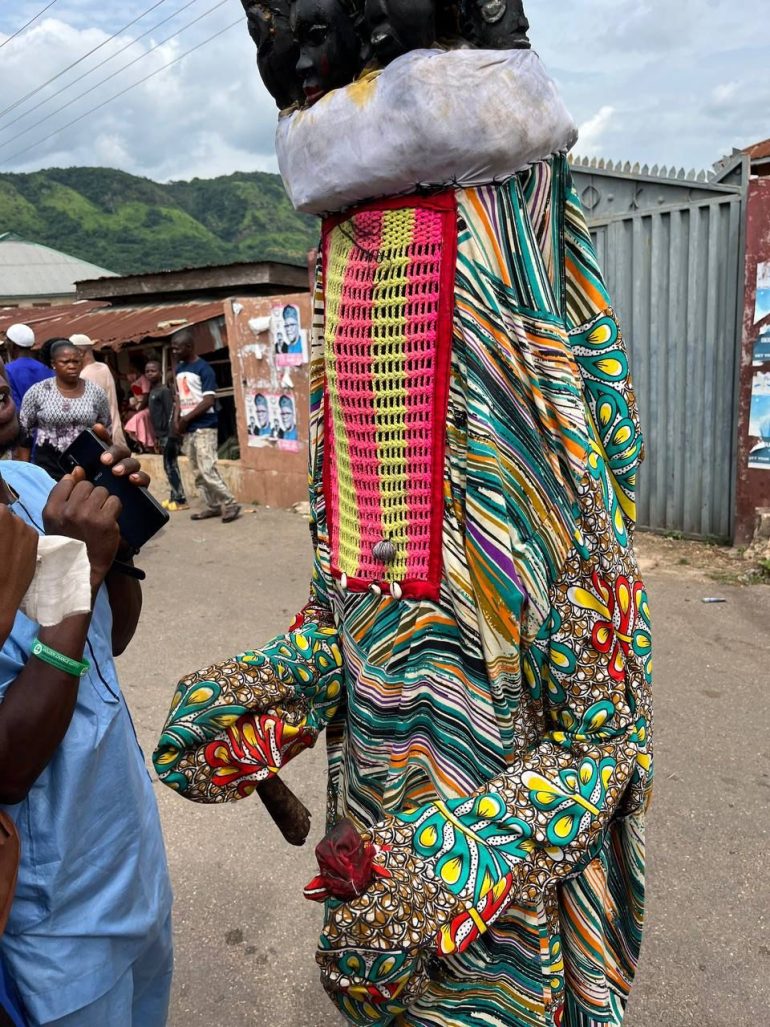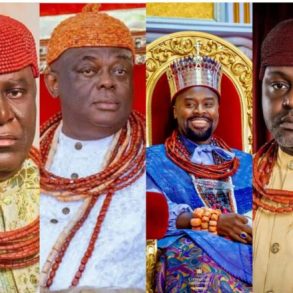I recently received a horrible email from someone. Simple: Is masquerade advantageous to the Yorùbá people? was the email’s subject line. My obvious response would be a resounding “YES!” as someone who prioritizes Yorùbá cultural identities. Even so, I refrained from answering “yes” because doing so would have been too tempting, even patronizing. Masquerading in the Yorùbá worldview goes beyond practices requiring advertisement. Our world is one of masking. Yorùbá is Egúngún, and Egúngún is Yorùbá.
I was born in a traditional Yorùbá settlement. I won’t mention her by name since her nickname, lgan—the town or house of the ancestors, or Egúngún—speaks for itself. Egúngún served as the foundation and pillars of my town as I grew up.
My community is not an outlier when it comes to how much Yorùbá communities value masquerade; for them, it is the most significant time of the year. The masquerade in my town is as old as the town itself.
The masquerade celebrations are important to Ìlú Àgan. Every lineage household in the ancient town has a masquerade and parades it throughout the annual masquerade season. Because of this, locals and visitors are frequently led into amazement at the magnificent visits by the countless ancestors who gutturally boom sounds from the outside world. In response to the ancestral apparition, the children of the noble Ìlú Àgan burn in long life, great success, and prosperity. The ancestors parade and consecrate the town.
Well, my town is not an exception in valuing masquerading; most Yorùbá communities celebrate masquerade as the most important season of every year. My town’s masquerade is as aged as the town’s history.
Hence, responding “yes” to the email in question would be a simplicity I try to avoid. Instead, I briefly discuss the scientific, historical, and socio-philosophical relevance of masquerades among the Yorùbá people globally in this open letter of reciprocity to my buddy, who is curious as to whether masquerades are of any benefit to the Yorùbá .
Scientists from the past
Egúngún is a Yorùbá word with a number of implications. I picked the oral tradition that is most similar to Egúngún out of the many others. Egungun is the name of it. The Yorùbá language has tones, therefore Egungun and Egúngún sound differently; the first one conveys “bones” or “skeleton.” According to one of the oral histories, the term “masquerade” originated from the Yorùbá word “egungun,” which means “bones.” As a result of the name’s similarity to the term bones, which can refer to any bone, our forebears deliberately called it Egúngún. They deliberately twist the sound to suggest Egúngún—a proper noun—in order to identify the ancestors’ bones from other types of bones. In Yorùbá ideas, the twitching of the names of significant individuals is nothing new; it is done to signify individuality, reverence, and respect. As a proper noun, bones stand in for both our male and female forebears. Later, I’ll delve deeper into that. But let’s first concentrate on the scientific purposes of masquerades.
When discussing the skeleton or bones, consider the biological and medical sciences. The foundation of every living creature is its bones. A person without bones is essentially considered to be dead. Your bones determine how well you can walk, lift objects, exercise, and carry out daily tasks. In actuality, your bones are what give you your excellent looks, chewing ability, and grin. Your bones are essential for breathing, excreting waste products, producing red and white blood cells, storing vitamins and minerals, and assimilating nutrition. Simply said, the bones are necessary for every component of the body to operate. These scientific truths about human existence were given to our masquerades by our forefathers, who also gave us the instruction to celebrate them frequently. Indeed, they are scientists.
Historical backgrounds, aesthetics, and socio-philosophical functions of masquerade practices
As old as the Yorùbá people are masquerades. This is so because the Yorùbá never engage in any activity that excludes their ancestors. It makes sense to include your ancestors in all of your endeavors since doing so shows that you value and are reconnected to your roots. Think of a river without a source or a tree without roots. A river without a source dries up quickly, and a tree without roots quickly gets withered. Similar to this, a Yorùbá without masks ceases to exist right away. In fact, failing to respect one’s origins and source is the foundation of many of the issues the Yoruba people seem to be having today. Just look at the developed countries of today, from Asian societies to those in Europe (China, Japan, etc.), to name a few. The finest people in the world are those who have a strong, unwavering devotion to their origins, sources, and other aspects of identity.
Our ancestors knowingly incorporated this masquerading as empowerment in all life endeavors. Elders of Ìlú Àgan (who inspired this article) revive their memories of the past with passion and nostalgia, reiterating stories of past sustenance, from migrations to self-defense, from the five-hundred-year transatlantic slavery that joined and continued the already ongoing trans-Saharan version, threatening populations, innovations, and the development of African societies. The hundred-year Yorùbá civil war of the 19th century—majorly facilitated by the ongoing external demand for able-bodied Africans for enslavement, the 1804-Islamic Jihadist—ended with the sixteen-year Kiriji series of wars, in which Ìlú Àgan, under the tutelage of the Brave Fabunmi, led the Èkìtì and Ijesa to defend the region. The external oppressions ended with our people’s resistance to colonialism and the missionaries. In all of these, our ancestors stood steadfast, backed by the Egúngún cult.
Our masquerades stood by us in times of difficulty; they also celebrated with us in times of merriment. For instance, while opponent groups used the masquerade to struggle for lands around the period surrounding the story of Mọ́remí in Ilé-Ifè, Aláàfin Sàngó summoned the revival of the royal Masquerade to celebrate the memory of his father, Ọ̀rànmíyàn in Òyó. Sàngó placed a woman, Ìyá Mọdẹ as custodian of the masquerade celebrations.
There are various types of masquerades, including the Epá, Ẹ̀yọ̀, Gẹ̀lẹ̀dẹ́, amongst others; even today, new masquerades are being created. Thus, masquerades can generally be analyzed to explore the histories and realities of a community or inter-communities, for example, the masquerades of riverine areas also portray sea animals. Today we know the historical influence of Òyó, Ìgbómìnà, and the likes of Ìlú Àgan, because some masquerade motifs such as masks, costumes (èkú) dancing styles, and drumbeats reveal unambiguous evidence.
With this brief historical overview, one can conclude that masquerade practices emerged and continue to shape the Yorùbá world in three forms: ritual, festival, and theater.
Some masquerades are embellished with dozens of taboos. These are examples of masquerades with ritual functions. The functions include the defense of communities, the burial of important persons, and the carrying of libations and sacrifices to conspicuous spaces. Besides, sacred masquerades were used to chase terrible or unwanted people out of the community. In the past, if an epidemic, like the Corona virus, broke out, our ancestors used masquerades to take affected people to a secular place or forest. These masquerades mediated between the families of the sick and the medicine officials (oníṣègùn), by delivering foods and medicines to the quarantined sick patient. Because of the supernatural powers and integrity believed to dwell in their masks and costumes, masquerades were integrated into indigenous medical, political, and sociocultural systems.
The second category, the festival masquerades, lead parades during anniversaries and ceremonies, such as coronations, namings, marriages, funerals, and so on. In the past, during national ceremonies, some, but not all, of the other ritual and theater masquerades descended into communities, but the festival masquerades led the season.
The third category, the theater masquerades, as the name implies, are performers. Often called Alárìnjó, they were acrobatic and dramatic. They were usually highly talented, displaying magical performances. They remind one of modern-day musical theater and concerts. The most documented Alárìnjó in Yorubaland originated in Òyó. As far back as the 1500s, or around the period when Òyó relocated to Igboho, the Alárìnjó were already performing in royal courts, public spaces and were already traveling throughout the Yorùbáland and West Africa as a whole. There is hardly any Yoruba town that has no memory of the Alárìnjó. The Yorùbá film industry emanated from the Alárìnjó. In fact, Yorùbá modern theater and film production rub shoulders with the likes of the British Shakespeare theater, which precedes the British modern movies. Yorùbá performance productions precede American Hollywood; Nigeria’s Nollywood actually emerged from the Yorùbá performance industry, not the other way around. Many Europeans who visited Yorùbáland in the nineteenth century marveled at the live entertainment provided by the Yorùbá performance groups, thanks to the masqueraders.
Why do some people resent the masquerades?
One of the major reasons why some people hate our masquerades is because they are often associated with evil. This is one of the problems that foreign norms and colonizers invented in all the societies they colonized. The idea is to brainwash you into believing that everything about you is evil, so as to make their own religions and cultures lucrative to you. Imagine: I cultivate a yam farm just as you do; the only way to convince you to buy mine is to brainwash you that your version of yam is bad and poisonous; if you eventually get brainwashed by believing me and rejecting your own yam, you consequently make me rich. The people who brainwashed you also have their own bad sides and have improved on some of them today. Why, then, do you choose their brainwashing legacies?
Taboos against women?
Some detest masquerades because of certain restrictions, which affect strangers and women. First and foremost, let me point out that there are dozens of religions in the world today that restrict all women. Even the ones you are practicing and that you consider holy. I don’t have to mention names; you know what I’m talking about.
The interesting news is that Yoruba masquerades are not anti-women. In fact, the Yoruba masquerades are pro-women. The problem is that many lack knowledge of the complex Yoruba world. In fact, the Yoruba masquerades are pro-women. No Yoruba institution rejects women, because women, Ìyá, are the patrons of Yoruba institutions. Beginning with the myth of creation in one of the Odù Ifà, Olodumare ordered all the pantheon to include the woman, or else they would fail in their endeavors. Remember, I mentioned above that a woman, Ìyá Mọdẹ, was in charge of the Oyo royal masquerade. All Alaafin called her “Bàbá”, because masquerades and their custodians don’t embody human sex, male or female. They embody what they represent: Ìyá Mọdẹ embodies the royal ancestors. There is more to this that I will not discuss here. Even today, women are part of the masquerades; hence, you hear calls like Ìyá Àgan.
Besides, there are three categories of women in Yorùbá thinking: pre-puberty, adolescent and childbearing age, and menopausal age. The first and third are freer and participate in gender-fluid space with men, while the middle is often restricted in certain sacred places, for reasons such as menstruation, like many world institutions. Besides, curfews and other restrictions affected virtually everybody, especially strangers. Note that there are no religious, spiritual, or other cultural institutions in the world without rules and regulations.
So, are you still wondering what the benefits of masquerades are, or will you now start appreciating our ancestors for giving us a life of fulfillment and sustainability? They taught us to value ourselves and our environment. Today, the world is wailing about environmental decline and damages, but masquerades and/or the òrìṣà already invested in us the philosophical knowledge tools to enable us to save the environment. Entertainment dominates the world today, but uncountable creativity is already encoded in our masquerade institutions. Go to Brazil, and you’ll marvel at how our Yoruba siblings have developed masquerades into the world’s number one carnival. The question is not whether masquerade is beneficial or not. The fact is that masquerade is Yorùbá, and Yorùbá is masquerade.






